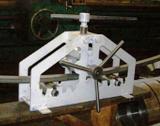Profile benders: characteristic features of the tool and the principle of operation
 The rollers are special machines for bending profiles using the cold rolling method. In order to achieve certain parameters of curvature, nozzles are sometimes used together with these devices, which make it possible to process profiles of a rather complex shape. Today, profiles are used to bend all kinds of pipes, beams, solid blanks, corners and channels, as well as rods at any angle (360 degrees). This machine allows you to turn the corner into a circle, and the profile and pipes into a spiral. It has no significant differences from other tools designed for bending profiles. There are mechanical, electrical and universal machines, each of which has its own characteristic features. If you use different tools, you can get profiles with symmetrical and asymmetrical contours.
The rollers are special machines for bending profiles using the cold rolling method. In order to achieve certain parameters of curvature, nozzles are sometimes used together with these devices, which make it possible to process profiles of a rather complex shape. Today, profiles are used to bend all kinds of pipes, beams, solid blanks, corners and channels, as well as rods at any angle (360 degrees). This machine allows you to turn the corner into a circle, and the profile and pipes into a spiral. It has no significant differences from other tools designed for bending profiles. There are mechanical, electrical and universal machines, each of which has its own characteristic features. If you use different tools, you can get profiles with symmetrical and asymmetrical contours.
Currently, this equipment is used in the construction, automotive, petrochemical, electrical, energy industries.Such devices are quite reliable, small in size, so they can be placed in a room with a modest area. In addition, they are characterized by low energy consumption. The main advantages of these tools are:
- Possibility to bend the profile for 1 rental;
- Processing can be done in any planes (in vertical or horizontal position).
In addition, the principle of operation of such devices is relatively simple.
Rollers: how different types of equipment work
Machines for bending metal structures roll the entire profile between rollers in a predetermined position of the bending radius. Such bending profiles are used to work with fairly large profiles. With their help, you can create closed and open loops with smooth transitions. The principle of operation of profile machines may be slightly different. For example, in conventional equipment of the classic type, during the bending process, the end of the profile rises together with the upper roll, breaking away from the feed roll tables. On other tools, thanks to the operation of hydraulic drives, the lower rollers move vertically.
Thus, the roller on the left rises until it touches the profile, and on the right sets the required bending radius. In this case, the end of the pipe or other structure will not rise up, but will slide down the support rollers or roller table. Such beams are usually used when it is necessary for the parameters of the products to be the same. Basically, this equipment makes it possible to perform very complex work, to increase labor productivity.
